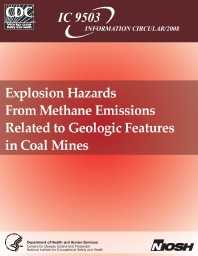Mining Publication: Explosion Hazards From Methane Emissions Related to Geologic Features in Coal Mines
Original creation date: April 2008
Explosions in U.S. coal mines have caused death and injury to miners and destruction of workings since the first reported explosion in 1810. These explosions are caused when buildups of explosive gas and/or dust in the mine are ignited by the presence of a flame or spark. Methane gas is inherently generated and held by adsorption in coal and is normally liberated during mining. Because this gas is explosive in the range of 5%-15% by volume, fresh air is constantly supplied to the working face to prevent the methane/air mixture from reaching this explosive range. The required amount of ventilation air is based on estimates of gas release under normal conditions. Occasionally, unanticipated and unusually high emissions are encountered, which, despite normal ventilation controls, result in an explosive mixture that a spark from a cutting bit or electrical equipment can easily ignite. Investigations have shown that such emissions are often associated with anomalous geologic features or conditions. Although most operators are aware that certain geologic features may adversely affect productivity, few are aware of their potential as a gas emission hazard. This report presents a historical framework detailing the impact of geologic features on excess gas emissions and resultant mine explosions. It also provides operators with specific information on recognizing and alleviating potential hazards from methane emissions related to these geologic features.
Authors: JP Ulery
Information Circular - April 2008
NIOSHTIC2 Number: 20033694
Pittsburgh, PA: U.S. Department of Health and Human Services, Public Health Service, Centers for Disease Control and Prevention, National Institute for Occupational Safety and Health, DHHS (NIOSH) Publication No. 2008-123, Information Circular 9503, 2008 Apr; :1-18
See Also
- Investigation of Methane Emissions From an Advancing Face in the Belle Isle Domal Salt Mine, Louisiana
- Methane Absorption in Oil Shale and Its Potential Mine Hazard
- Methane Content of Gulf Coast Domal Rock Salt
- Methane Control by Isolation of a Major Coal Panel - Pittsburgh Coalbed
- Methane Diffusion Parameters for Sized Coal Particles: A Measuring Apparatus and Some Preliminary Results
- Methane Emission from U.S. Coal Mines, A Survey
- Methane Emission Rate Studies in a Northern West Virginia Mine
- Modeling and Prediction of Ventilation Methane Emissions of U.S. Longwall Mines Using Supervised Artificial Neural Networks
- Reservoir Rock Properties of Coal Measure Strata of the Lower Monongahela Group, Greene County (Southwestern Pennsylvania), from Methane Control and Production Perspectives
- Technology News 465 - Method for Predicting Methane Emissions on Extended Longwall Faces
- Content source: National Institute for Occupational Safety and Health, Mining Program


 ShareCompartir
ShareCompartir
